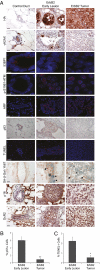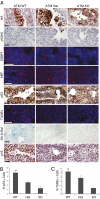Defining the ATM-mediated barrier to tumorigenesis in somatic mammary cells following ErbB2 activation
- PMID: 20133707
- PMCID: PMC2840493
- DOI: 10.1073/pnas.0910665107
Defining the ATM-mediated barrier to tumorigenesis in somatic mammary cells following ErbB2 activation
Abstract
p53, apoptosis, and senescence are frequently activated in preneoplastic lesions and are barriers to progression to malignancy. These barriers have been suggested to result from an ATM-mediated DNA damage response (DDR), which may follow oncogene-induced hyperproliferation and ensuing DNA replication stress. To elucidate the currently untested role of DDR in breast cancer initiation, we examined the effect of oncogene expression in several murine models of breast cancer. We did not observe a detectable DDR in early hyperplastic lesions arising in transgenic mice expressing several different oncogenes. However, DDR signaling was strongly induced in preneoplastic lesions arising from individual mammary cells transduced in vivo by retroviruses expressing either PyMT or ErbB2. Thus, activation of an oncogene after normal tissue development causes a DDR. Furthermore, in this somatic ErbB2 tumor model, ATM, and thus DDR, is required for p53 stabilization, apoptosis, and senescence. In palpable tumors in this model, p53 stabilization and apoptosis are lost, but unexpectedly senescence remains in many tumor cells. Thus, this murine model fully recapitulates early DDR signaling; the eventual suppression of its endpoints in tumorigenesis provides compelling evidence that ErbB2-induced aberrant mammary cell proliferation leads to an ATM-mediated DDR that activates apoptosis and senescence, and at least the former must be overcome to progress to malignancy. This in vivo study also uncovers an unexpected effect of ErbB2 activation previously known for its prosurvival roles, and suggests that protection of the ATM-mediated DDR-p53 signaling pathway may be important in breast cancer prevention.
Conflict of interest statement
The authors declare no conflict of interest.
Figures



Similar articles
-
The Myc-evoked DNA damage response accounts for treatment resistance in primary lymphomas in vivo.Blood. 2007 Oct 15;110(8):2996-3004. doi: 10.1182/blood-2007-02-075614. Epub 2007 Jun 11. Blood. 2007. PMID: 17562874
-
Ataxia telangiectasia mutated (ATM) inhibition transforms human mammary gland epithelial cells.J Biol Chem. 2010 Apr 23;285(17):13092-106. doi: 10.1074/jbc.M109.078360. Epub 2010 Feb 22. J Biol Chem. 2010. PMID: 20177072 Free PMC article.
-
Phosphorylation of p53 serine 18 upregulates apoptosis to suppress Myc-induced tumorigenesis.Mol Cancer Res. 2010 Feb;8(2):216-22. doi: 10.1158/1541-7786.MCR-09-0324. Epub 2010 Feb 9. Mol Cancer Res. 2010. PMID: 20145032 Free PMC article.
-
Metformin and the ATM DNA damage response (DDR): accelerating the onset of stress-induced senescence to boost protection against cancer.Aging (Albany NY). 2011 Nov;3(11):1063-77. doi: 10.18632/aging.100407. Aging (Albany NY). 2011. PMID: 22170748 Free PMC article. Review.
-
p53: guardian of the genome and policeman of the oncogenes.Cell Cycle. 2007 May 2;6(9):1006-10. doi: 10.4161/cc.6.9.4211. Epub 2007 May 28. Cell Cycle. 2007. PMID: 17457049 Review.
Cited by
-
Mammary cells with active Wnt signaling resist ErbB2-induced tumorigenesis.PLoS One. 2013 Nov 12;8(11):e78720. doi: 10.1371/journal.pone.0078720. eCollection 2013. PLoS One. 2013. PMID: 24265712 Free PMC article.
-
APOBEC3A and APOBEC3B Preferentially Deaminate the Lagging Strand Template during DNA Replication.Cell Rep. 2016 Feb 16;14(6):1273-1282. doi: 10.1016/j.celrep.2016.01.021. Epub 2016 Jan 28. Cell Rep. 2016. PMID: 26832400 Free PMC article.
-
Clustered and genome-wide transient mutagenesis in human cancers: Hypermutation without permanent mutators or loss of fitness.Bioessays. 2014 Apr;36(4):382-393. doi: 10.1002/bies.201300140. Epub 2014 Feb 26. Bioessays. 2014. PMID: 24615916 Free PMC article.
-
Lower expression of ATM and gene deletion is more frequent in adrenocortical carcinomas than adrenocortical adenomas.Endocrine. 2012 Jun;41(3):479-86. doi: 10.1007/s12020-012-9593-3. Epub 2012 Feb 4. Endocrine. 2012. PMID: 22311173
-
The gain of function of p53 cancer mutant in promoting mammary tumorigenesis.Oncogene. 2013 Jun 6;32(23):2900-6. doi: 10.1038/onc.2012.299. Epub 2012 Jul 23. Oncogene. 2013. PMID: 22824795 Free PMC article.
References
-
- Halazonetis TD, Gorgoulis VG, Bartek J. An oncogene-induced DNA damage model for cancer development. Science. 2008;319:1352–1355. - PubMed
-
- Venkitaraman AR. Medicine: aborting the birth of cancer. Nature. 2005;434:829–830. - PubMed
-
- Lowe SW, Cepero E, Evan G. Intrinsic tumour suppression. Nature. 2004;432:307–315. - PubMed
-
- Bartek J, Bartkova J, Lukas J. DNA damage signalling guards against activated oncogenes and tumour progression. Oncogene. 2007;26:7773–7779. - PubMed
-
- Kastan MB. DNA damage responses: Mechanisms and roles in human disease: 2007 G.H.A. Clowes Memorial Award Lecture. Mol Cancer Res. 2008;6:517–524. - PubMed
Publication types
MeSH terms
Substances
Grants and funding
LinkOut - more resources
Full Text Sources
Medical
Molecular Biology Databases
Research Materials
Miscellaneous

